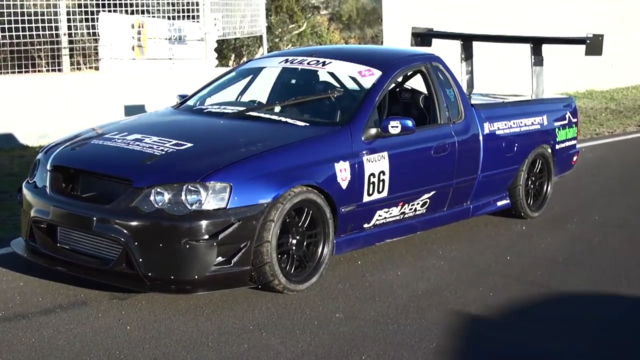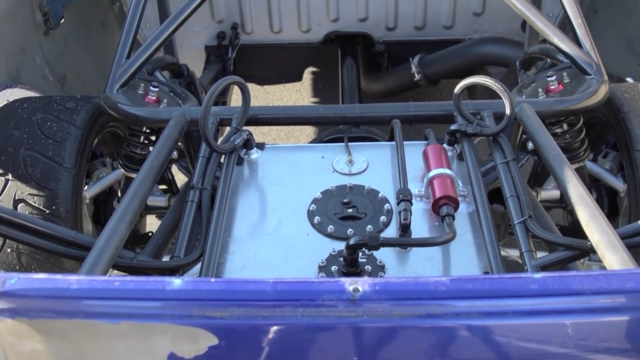The car culture down under is diverse, involving an odd mix of big-bore Aussie-V8 powered machinery and nimble, Japanese bruisers. Typically, it’s the Japanese cars that use turbochargers, but Ford’s lineup includes a few cars that boast a force-fed engine, one of which being the Ford Falcon ute. A Ute, short for utility, is quite similar to pickups as Americans know them, though the cab and the cargo tray are not separated, but rather part of a monocoque design. The Falcon ute is a rarity in that it is demarcated between the cab and the bed, but that doesn’t make it any less of an oddity — with 330 horsepower in stock form and the ability to lug a few hundred pounds of fertilizer, it’s certainly an uncommon recipe.

Though it looks out of place, it gets the racing accessories in the form of aero bits, Enkei wheels and a giant intercooler.
Perhaps that’s just American ignorance, but even the owner of this car, Ian Porter, seems to appreciate the absurdity of a pickup intended for time attack racing. The 4.0-liter straight-six fitted with a GTW3582 turbocharger, which brings boost on early as 2,500 rpm, pulls hard to the redline. With 540 horsepower and very little weight over the rear wheels, that delivery might as well be an on-off switch, as it appears effortless to light up the tires with a prod of the throttle. But hey, this build was not intended to be the most effective — there’s fun in the outlandish approach.
As this ute became a donor shell after a rear-end collision, Porter took it upon himself to improve the rear end capacity and precision with the addition of a 300ZX Twin Turbo subframe and a custom tubed rear. The subframe, in addition to giving the package independent rear suspension, is fairly stout and handles 1,200 horsepower. Considering the Barra motor in its current state is boosted to a mere 14 pounds, it’s safe to assume there’s more to be asked from this rear end as time goes on.

The addition of a Z’s rear end gives the car poise, but still struggles to put the power down with no weight atop.
While that lightweight rear end and long, front-mounted engine aren’t exactly ideal for a road racing platform, the car has adopted several lightweight aerodynamic components to improve grip at both ends. An exposed bed is an aerodynamic nightmare, imposing a good amount of drag, so to help on that front, a custom, 25-pound cover. The air routed in that direction then flows over the giant GT wing from Top Stage Composites, which should push those rear tires into the asphalt. Balancing in the other direction is a set of canards and a lightweight splitter, all from JSAI Aero, and in the coming months, a flat floor has been proposed. How often does a truck benefit from aerodynamic aids on this sort of level?
What this ute build shows is that with a bit of cash and some dedication, a head-turning package can be built quickly. More importantly, the lighthearted approach comes through in an odd choice of a truck and, with the right set of parts, prove that the platform can still be quick. While it’s not a proven route to take, modifying a ute for time attack is unique and fun, and ultimately, that’s what matters.





















